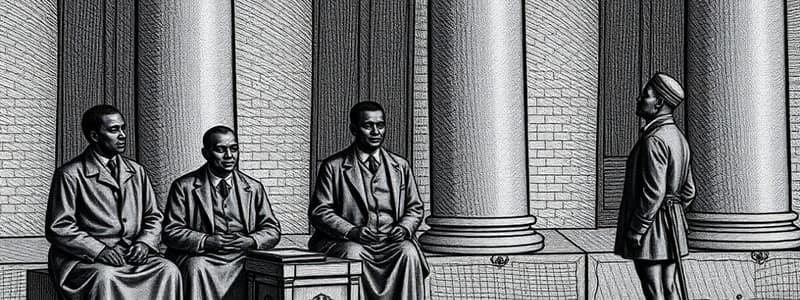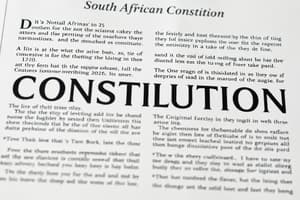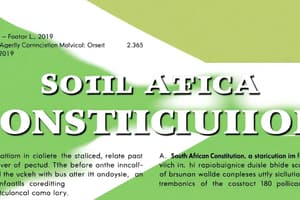Podcast
Questions and Answers
What were the two major legal systems affecting South Africa's populations before 1994?
What were the two major legal systems affecting South Africa's populations before 1994?
The two major legal systems were common law, which applied to the white population, and customary law, which applied to black South Africans.
How did the Union of South Africa in 1910 contribute to the racial segregation in governance?
How did the Union of South Africa in 1910 contribute to the racial segregation in governance?
The Union formalized a bifurcated state by establishing a Westminster system for the white population while allowing traditional governance for indigenous peoples, but under white control.
What role did traditional governance structures play in indigenous communities before 1994?
What role did traditional governance structures play in indigenous communities before 1994?
Traditional governance structures, centered around chiefs, continued to operate for indigenous South Africans but were controlled by the white government.
In what ways do the remnants of apartheid-era laws manifest in modern South Africa?
In what ways do the remnants of apartheid-era laws manifest in modern South Africa?
Signup and view all the answers
What was the societal impact of the racial division evident in South Africa's legal system before 1994?
What was the societal impact of the racial division evident in South Africa's legal system before 1994?
Signup and view all the answers
How do judges in South Africa reinterpret the Constitution over time?
How do judges in South Africa reinterpret the Constitution over time?
Signup and view all the answers
What acknowledgment do justices of South Africa's Constitutional Court make regarding the Constitution's language?
What acknowledgment do justices of South Africa's Constitutional Court make regarding the Constitution's language?
Signup and view all the answers
What challenge do judges face with the general language of the Constitution, according to Kentridge J?
What challenge do judges face with the general language of the Constitution, according to Kentridge J?
Signup and view all the answers
In what way do judges strive to remain objective when interpreting open-ended provisions?
In what way do judges strive to remain objective when interpreting open-ended provisions?
Signup and view all the answers
What underlying principle is emphasized regarding the meaning of the Constitution?
What underlying principle is emphasized regarding the meaning of the Constitution?
Signup and view all the answers
How have traditional indigenous governance structures in South Africa influenced modern constitutional law?
How have traditional indigenous governance structures in South Africa influenced modern constitutional law?
Signup and view all the answers
What was the impact of colonialism on indigenous governance structures in South Africa?
What was the impact of colonialism on indigenous governance structures in South Africa?
Signup and view all the answers
What was the Glen Grey Act of 1894 and its significance in the governance of South Africa?
What was the Glen Grey Act of 1894 and its significance in the governance of South Africa?
Signup and view all the answers
In what ways can indigenous governance structures be perceived as problematic from a modern perspective?
In what ways can indigenous governance structures be perceived as problematic from a modern perspective?
Signup and view all the answers
What role did co-operative governance provisions in the South African Constitution play in relation to indigenous governance?
What role did co-operative governance provisions in the South African Constitution play in relation to indigenous governance?
Signup and view all the answers
Study Notes
South Africa's Bifurcated Constitutional History
- South Africa's constitutional history before 1994 featured extreme racial segregation and discrimination.
- The state operated on a bifurcated system with one system of rules for white settlers and another system of rules for indigenous people.
- This racial division is still apparent in the law applicable in South Africa.
- Common law, introduced by colonial rulers, primarily applied to white populations.
- Customary law, developed by indigenous people, applied to Black South Africans.
- Today, common and customary law are both relevant in modern South Africa, but their application remains distinct.
The Union of South Africa (1910)
- The Union of South Africa formalized the bifurcated state.
- A Westminster system of government was established, primarily applying to the white population.
- Traditional governance structures, centered around chiefs, continued to operate for indigenous people but under the control of the white government.
Interpreting the South African Constitution (1996)
- The interpretation and application of constitutional provisions are not static.
- Judges, while bound by precedent, can subtly reinterpret and reapply the text of the Constitution over time.
- Judges are human beings who are influenced by the society in which they live.
- They interpret the Constitution in ways shaped by social, economic, and political realities.
- The open-ended nature of the South African Constitution allows for extra-legal values and texts to be considered in decision-making.
Traditional Indigenous Governance
- Traditional governance structures of indigenous societies in South Africa are based on a form of communalism.
- These structures resonate with the cooperative government provisions in the modern South African Constitution.
- However, from a modern perspective, these structures may seem problematic because they don't reflect the democratic principles of a modern constitutional state.
Glen Grey Act (1894)
- The Glen Grey Act excluded Africans from the Cape Palament.
- It weakened the authority of traditional chiefs.
- It introduced a system of government-appointed district councillors.
- This act led to separate "reserve" areas where Africans lived.
- This effectively created a pseudo-democratic white state co-existing with an authoritarian system for indigenous people.
Union Constitution (1910)
- The Union Constitution adopted a Westminster style system of parliamentary government.
- The Union Parliament consisted of two houses: the House of Assembly and the Senate.
- The House of Assembly was directly elected by a limited number of male citizens.
- Members of the Senate were partly indirectly elected and partly nominated.
- The Constitution established South Africa as a unitary state, retaining the four former colonies as provinces.
- The Union Constitution retained a system of parliamentary supremacy.
- The South African legislature was initially restrained by the Colonial Laws Validity Act (1865) and the need for British Parliament's assent for bills.
The South African Constitution (1996) as a Transformative Document
- The South African Constitution is considered transformative.
- It aims to address the historical legacy of racism, authoritarianism, and repression.
- It strives to create a more democratic, universalistic, caring, and egalitarian society.
- The Constitution seeks to transform society from one divided by racial inequality to one based on equality and justice.
Unclear Outcome of Transformation
- The exact outcome of this transformation remains uncertain.
- The process is ongoing and its outcome is dependent on the interaction between various stakeholders.
- Despite the uncertainty, the transformation aims to ensure meaningful and deliberate participation in the process.
- Liberal constitutions aim to regulate and check public power, allowing for democratic decisions.
Studying That Suits You
Use AI to generate personalized quizzes and flashcards to suit your learning preferences.
Related Documents
Description
Explore South Africa's complex constitutional landscape prior to 1994, marked by profound racial segregation and discrimination. This quiz delves into the bifurcated legal systems that distinguished between white settlers and indigenous populations, examining the legacy that still influences South African law today.




